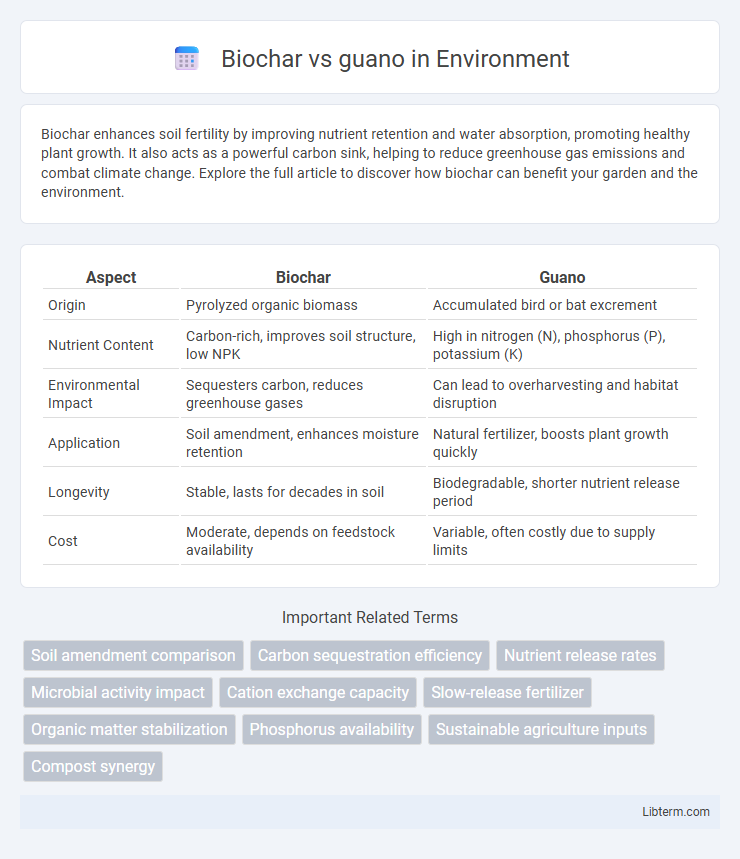Biochar enhances soil fertility by improving nutrient retention and water absorption, promoting healthy plant growth. It also acts as a powerful carbon sink, helping to reduce greenhouse gas emissions and combat climate change. Explore the full article to discover how biochar can benefit your garden and the environment.
Table of Comparison
| Aspect | Biochar | Guano |
|---|---|---|
| Origin | Pyrolyzed organic biomass | Accumulated bird or bat excrement |
| Nutrient Content | Carbon-rich, improves soil structure, low NPK | High in nitrogen (N), phosphorus (P), potassium (K) |
| Environmental Impact | Sequesters carbon, reduces greenhouse gases | Can lead to overharvesting and habitat disruption |
| Application | Soil amendment, enhances moisture retention | Natural fertilizer, boosts plant growth quickly |
| Longevity | Stable, lasts for decades in soil | Biodegradable, shorter nutrient release period |
| Cost | Moderate, depends on feedstock availability | Variable, often costly due to supply limits |
Understanding Biochar and Guano: Definitions and Origins
Biochar is a carbon-rich material produced through pyrolysis of organic biomass, primarily used to enhance soil fertility and sequester carbon. Guano consists of accumulated excrement from seabirds, bats, or seals, known for its high nitrogen, phosphorus, and potassium content, making it a potent organic fertilizer. Both biochar and guano originate from natural processes but differ fundamentally in composition and application within sustainable agriculture.
Composition and Nutrient Profiles
Biochar is primarily composed of carbon-rich materials produced through pyrolysis of organic matter, offering excellent soil structure enhancement and water retention but low nutrient content. Guano, derived from accumulated seabird or bat excrement, is rich in essential nutrients such as nitrogen, phosphorus, and potassium, providing immediate fertility boosts to soil. The nutrient profiles of guano are significantly higher in macronutrients, while biochar mainly acts as a soil conditioner and nutrient carrier rather than a direct nutrient source.
Soil Improvement Capabilities
Biochar enhances soil structure by increasing porosity, water retention, and microbial activity, leading to improved nutrient cycling and long-term fertility. Guano provides a rich source of nitrogen, phosphorus, and potassium, promoting rapid nutrient availability and plant growth. While biochar supports sustainable soil health over time, guano offers immediate nutrient boosts essential for intensive cultivation.
Effects on Plant Growth and Yield
Biochar enhances plant growth and yield by improving soil structure, water retention, and nutrient availability, leading to increased root development and microbial activity. Guano, rich in nitrogen, phosphorus, and potassium, provides immediate nutrient supply that accelerates plant growth and boosts crop yields. Combining biochar with guano can synergistically improve soil fertility and sustain long-term productivity in agricultural systems.
Application Methods and Best Practices
Biochar is commonly applied through soil incorporation, mixing it into the topsoil to enhance nutrient retention, water holding capacity, and microbial activity, often at rates of 5-10% by volume for optimal results. Guano, rich in nitrogen, phosphorus, and potassium, is typically used as a high-value organic fertilizer applied directly to the soil surface or as a diluted foliar spray to provide immediate nutrient availability, especially during key growth stages. Best practices include combining biochar with compost or guano to synergize long-term soil conditioning with rapid nutrient release, ensuring balanced application rates to avoid nutrient burn or soil pH imbalance.
Environmental Impact and Sustainability
Biochar enhances soil carbon sequestration by stabilizing organic matter for centuries, reducing greenhouse gas emissions and improving soil health sustainably. Guano, rich in nitrogen, phosphorus, and potassium, boosts crop yields but can lead to nutrient runoff and ecosystem imbalance if overused, harming aquatic systems. Sustainable use of biochar supports long-term soil fertility and climate mitigation, while guano requires regulated application to minimize environmental degradation.
Longevity and Stability in Soil
Biochar exhibits exceptional longevity and stability in soil due to its highly aromatic carbon structures, which can persist for hundreds to thousands of years, enhancing long-term soil carbon sequestration. In contrast, guano, rich in readily available nitrogen and phosphorus, decomposes rapidly, providing immediate nutrient release but lacking durable soil carbon retention. This difference positions biochar as a superior amendment for sustained soil health and climate mitigation, while guano serves best for short-term fertility boosts.
Cost Effectiveness and Accessibility
Biochar offers long-term soil improvement with relatively low production costs using agricultural waste, making it highly cost-effective for sustainable farming, while guano, sourced from bat or seabird droppings, often incurs higher costs due to limited availability and extraction challenges. Biochar's accessibility is enhanced by local biomass resources, especially in rural areas, whereas guano accessibility depends on specific geographic locations and environmental regulations protecting natural habitats. Farmers seeking affordable, scalable soil amendments tend to choose biochar for its wider availability and economic advantages over the more expensive, less accessible guano fertilizer.
Suitability for Different Crops and Climates
Biochar enhances soil structure and moisture retention, making it ideal for crops in arid and nutrient-poor regions, while guano provides a rich, fast-release source of nitrogen, phosphorus, and potassium, benefiting high-yielding crops requiring immediate nutrient availability. Biochar is particularly suitable for improving soil health over time in various climates, including temperate and tropical zones, whereas guano is best for short-term nutrient boosts in fertile soils, often used in tropical and subtropical agriculture. Crop-specific suitability depends on the soil nutrient needs and climate conditions; biochar supports long-term crop resilience, and guano drives rapid growth in nutrient-demanding plants.
Choosing Between Biochar and Guano: Key Considerations
Choosing between biochar and guano depends on soil health goals, nutrient content, and environmental impact. Biochar enhances soil structure, increases microbial activity, and sequesters carbon, making it ideal for long-term soil improvement. Guano provides a rich source of nitrogen, phosphorus, and potassium, promoting rapid plant growth but requires careful application to avoid nutrient runoff.
Biochar Infographic

 libterm.com
libterm.com